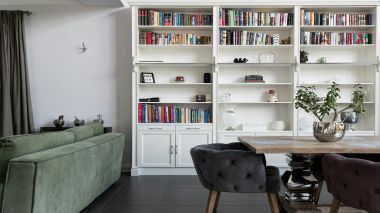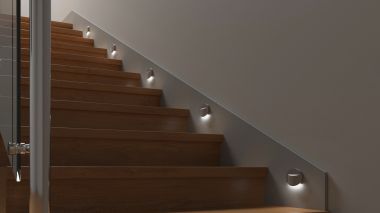4 rules for setting up lighting for study corner
September brings about two things that are not necessarily everyone's favourite : the start of the academic year and shorter days. Both these elements make parents think about purchasing some extra equipment for spaces, where their children do their homework. What should we bear in mind when arranging the lighting for a study corner?

Introduce as much natural light as possible
An area that gets the most daylight at noon should be the one designated for studying. Did you know that by placing a desk next to the window, you improve the odds for of better results in studying for your child? Make sure you bear that in mind, because of how much you're going to save on electricity. We also should not forget that working with one type of lightning is less taxing for the eye. This is why it's not a good idea to combine incandescent light bulbs with sunlight for the study corner. Your children would be much better off with a lamp with an easily adjustable light intensity, like Kanlux FRANCO on their desk. Whenever there's less light coming in from outside the window, this can be gradually remediated.
Adjust the light beam
There should be an appropriate height - from 35 to 40 cm - between the desk and the light source that is the desk lamp. When choosing a desk lamp, do bear in mind that the light has to be set in a way that casts the least amount of shadow. This is precisely why those who are right-handed should have it on their left and the those who are left-handed - on their right. A strong contrast of the illuminated, bright desk surface against a dark background also puts a lot of strain the eyes. Using both general light and a directed lamp, let's say Kanlux PIXA, illuminating the "working area" of the desk is optimal for studying. Remember that lamps should always be positioned so that the light does not cause any glare on the monitor. It's best to avoid placing a light source behind the back of the person sitting at the desk, as this creates an unnecessary shadow that can make it difficult to focus.
Adjust lighting parameters according to the needs
Technically, the more lumens a lamp has, the better, but it's best not to go overboard with the brightness either. A brightness of around 600 lumens is best for your eyes, but this is not the only parameter you need to pay attention to. The colour temperature of the light is just as important; the higher it is, the cooler it is. For studying, a natural or cold colour (between 4000K and 6500K) will be the most optimal setting - it will help you concentrate and it won't tire out your eyes. Remember to take short breaks more often with cold colours and give your eyes moment to rest a bit. Do not use the warm one for studying, as it increases the sense of drowsiness. In order to optimally adapt them to the current needs, it is certainly worthwhile to have a feature of adjusting the colour and intensity of the light, the one that Kanlux REXAR brings to the table. In addition to the parameters of the light, you can also adapt the lamp itself... to the size of your desk, as it can be folded when you're done with working so that it takes up a minimum of space.
Make sure you see colours correctly
Parents very often overlook the colour rendering index, or CRI for short, when choosing lighting arrangement for doing homework. It also has a significant impact on the perception of all visual content, so it is something we should also consider. Lighting with a CRI of no less than 80 certainly provides optimum learning conditions and probably promotes higher art grades, although no studies have confirmed this so far. A lamp that meets this requirement is, for example, the Kanlux EMIRES LED. With the feature adjusting the arm in two axes of rotation it can be adapted to be adapted to the various needs of our younger users. Same goes for three light colour options (WW 3000K, NW 4000K, CW 6000K) and the smooth brightness control feature.
In conclusion, irrespective of the age of the user of the study corner, it is essential to take care of the key lighting parameters and make sure it has the feature of adjusting the position of the light source. Even if it meets your current requirements and you do not plan to change it, consider replacing the bulbs you have been using so far with Kanlux IQ-LED LIFE bulbs that are healthier for your eyes. They emit significantly less harmful blue light, their consumption costs are very low and their quality of manufacture is confirmed by German TÜV Rheinland certification. In addition, their CRI (mentioned in the previous paragraph) is above 90. After all, why not start the new school year by giving your eyesight and the wellbeing of your loved ones some proper attention, right?
Other articles
 How to light your home library and reading space?
How to light your home library and reading space?
Reading is one of those activities that truly allows you to pause—to break away from everyday life...
 Lighting for Mezzanine Floors and High Spaces — Challenges and Solutions
Lighting for Mezzanine Floors and High Spaces — Challenges and Solutions
Not every space has the grandeur of a cathedral — and that is quite fortunate. Low interiors, mezzanine...
 Staircase and Corridor Lighting — Safety and Design
Staircase and Corridor Lighting — Safety and Design
Stairs, corridors and other passageways have specific lighting requirements. This is not only for safety...
 Smart lighting management in your home – where to start?
Smart lighting management in your home – where to start?
Smart lighting systems are not only a matter of convenience, but also a conscious step towards better...
 How does LED lighting work?
How does LED lighting work?
The LED lighting in our homes, offices and public areas is here to stay. Today, it is hard to imagine...
 How can lighting create a spa atmosphere in your bathroom?
How can lighting create a spa atmosphere in your bathroom?
When designing a bathroom, not only aesthetics but also lighting matter—when selected appropriately,...